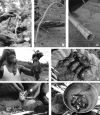Rat-atouille: A Mixed Method Study to Characterize Rodent Hunting and Consumption in the Context of Lassa Fever
- PMID: 26895631
- PMCID: PMC4996873
- DOI: 10.1007/s10393-016-1098-8
Rat-atouille: A Mixed Method Study to Characterize Rodent Hunting and Consumption in the Context of Lassa Fever
Abstract
Lassa fever is a zoonotic hemorrhagic illness predominant in areas across Nigeria, Sierra Leone, Guinea, Liberia, and southern Mali. The reservoir of Lassa virus is the multimammate mouse (Mastomys natalensis), a highly commensal species in West Africa. Primary transmission to humans occurs through direct or indirect contact with rodent body fluids such as urine, feces, saliva, or blood. Our research draws together qualitative and quantitative methods to provide a fuller and more nuanced perspective on these varied points of human-animal contact. In this article, we focus on the hunting, preparation, and consumption of rodents as possible routes of exposure in Bo, Sierra Leone. We found that the consumption of rodents, including the reservoir species, is widespread and does not neatly tally against generational or gender lines. Further, we found that the reasons for rodent consumption are multifactorial, including taste preferences, food security, and opportunistic behavior. We argue that on certain topics, such as rodent consumption, establishing trust with communities, and using qualitative research methods, is key to investigate sensitive issues and situate them in their wider context. To conclude, we recommend ways to refine sensitization campaigns to account for these socio-cultural contexts.
Keywords: Lassa fever; Mastomys natalensis; consumption; human–rodent interaction; hunting; mixed method.
Figures



References
-
- Akoua-Koffi C, Ter Meulen J, Legros D, Akraan V, Aïdara M, Nahounou N, Dogbo P, Ehouman A. Détection des anticorps anti-virus de Lassa dans l’Ouest forestier de la Côte d’Ivoire. Médecine tropicale. 2006;66:465–468. - PubMed
-
- Asogun DA, Adomeh DI, Ehimuan J, Odia I, Hass M, Gabriel M, Ölschläger S, Becker-Ziaja B, Folarin O, Phelan E, Ehiane PE, Ifeh VE, Uyigue EA, Oladapo YT, Muoebonam EB, Osunde O, Dongo A, Okokhere PO, Okogbenin SA, Momoh M, Alikah SO, Akhuemokhan OC, Imomeh P, Odike MAC, Gire S, Andersen K, Sabeti PC, Happi CT, Akpede GO, Günther S. Molecular diagnostics for Lassa fever at Irrua Specialist Teaching Hospital, Nigeria: lessons learnt from two years of laboratory operation. PLoS Neglected Tropical Disease. 2012;6:e1839. doi: 10.1371/journal.pntd.0001839. - DOI - PMC - PubMed
-
- Bausch DG, Demby AH, Coulibaly M, Kanu J, Goba A, Bah A, Condé N, Wurtzel HL, Cavallaro KF, Lloyd E, Binta Baldet F, Cissé SD, Fofona D, Savané IK, Tamba Tolno R, Mahy B, Wagoner KD, Ksiazek TG, Peters CJ, Rollin PE. Lassa fever in Guinea: I. Epidemiology of human disease and clinical observations. Vector Borne and Zoonotic Diseases. 2001;1:269–281. doi: 10.1089/15303660160025903. - DOI - PubMed
-
- Bonner PC, Schmidt W-P, Belmain SR, Oshin B, Baglole D, Borchert M. Poor housing quality increases risk of rodent infestation and Lassa fever in Refugee Camps of Sierra Leone. The American Journal of Tropical Medicine and Hygiene. 2007;77:169–175. - PubMed
-
- CIA (2014). The World Factbook: Africa: Sierra Leone. Central Intelligence Agency. https://www.cia.gov/library/publications/the-world-factbook/geos/sl.html. Accessed June 2014
MeSH terms
LinkOut - more resources
Full Text Sources
Other Literature Sources

